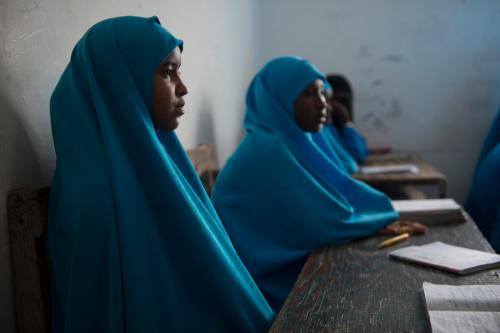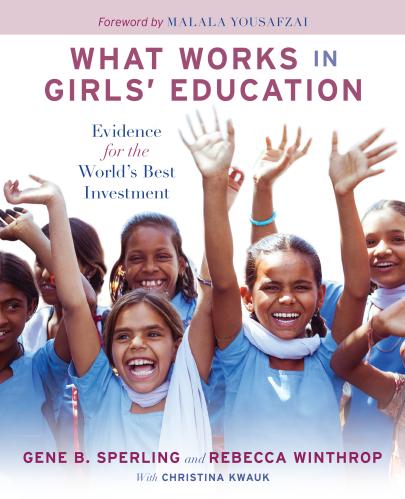The 2017 theme for International Women’s Day (IWD), March 8, focuses on “Women in the Changing World of Work: Planet 50-50 by 2030.”
Today, organizations, business leaders, and activists across the globe are holding events and organizing campaigns to celebrate IWD. With such widespread and diverse participation, we have a great opportunity to reevaluate the impact of multi-stakeholder interaction towards improving girls’ education, especially in Africa.
Around the world, the challenges we face in educating girls and women are complex, and the potential impacts are remarkable. Consider a few numbers:
- Across the African region, 29 million young and adolescent girls are out of school, and many will never set foot in a classroom. They often face early marriage, risk being trafficked, sold, sexually assaulted, or kidnapped.
- Of all regions, sub-Saharan Africa has the highest rates of education exclusion. Over one-fifth of children between the ages of about 6 and 11 are out of school, followed by one-third of youth between the ages of about 12 and 14. According to the UNESCO Institute for Statistics, almost 60 percent of youth between the ages of about 15 and 17 are not in school. These rates of exclusion are disproportionately represented by girls. In fact, worldwide, there are still 31 million girls of primary school age out of school—4 million more than the number of boys.
- Two-thirds of the 774 million illiterate people in the world are female.
- Educated women are less likely to die in childbirth: If all mothers in sub-Saharan Africa completed primary education, maternal deaths there would be reduced by 70 percent, saving 50,000 lives per year. Similarly, education lowers birth rates: In sub-Saharan Africa, the average birth rate for women with no education is 6.7, but for women with secondary education that number drops to 3.9.
- Education narrows pay gaps between men and women worldwide; in Pakistan for example, women with a primary education earn 51 percent what men earn. With a secondary education, they earn 70 percent what men earn.
- According to a University of Maryland and Columbia Business School joint study, gender diversity at the management level leads to a $42 million increase in value of S&P 500 firms. However, women hold only 12 percent of the world’s board seats.
Understanding different approaches to change in enhancing girls’ education
In myriad roles and with multiple organizations, I have spent decades fighting for transformational approaches to change, while taking part in both transactional and transformational initiatives. The concept of transaction versus transformation in business is often used when describing leadership styles. Transactional leaders focus on the role of supervision, organization, and group performance. They are concerned about day-to-day progress toward goals. Transformational leaders work to enhance the motivation and engagement of followers by directing their behavior toward a shared vision. While transactional leadership operates within existing boundaries of processes, structures, and goals, transformational leadership challenges the current state and is change-oriented.
Often transactions are linked or refer to the financial industry, company acquisitions, and other dealings, but transactions aren’t always about money and banking. Transactions can involve an exchange of ideas, listening to others with empathy and compassion, designing solutions with people that are supposed to benefit from them, and asking meaningful questions rather than prescribing solutions. We can better interact and make impact in our diverse transactions while promoting transformation.
Transactional leadership and change may work well when outcomes are simple and predictable––but when outcomes are complex, we need transformational change. For girls’ education, we must consider all factors when designing solutions on behalf of women and girls––for example, many girls drop out of school at the onset of menstruation, partly because there are no separate toilet facilities. Simply providing access to latrines is not enough, as girls’ involvement in identifying the location and type can be critical in determining whether they will continue to be used.
Despite millions of dollars of funding, awareness campaigns, and endless pilot projects, we sometimes focus too much on the transactional and not enough of the transformational. We aim for marketing wins or pilots that demonstrate engagement for a year-long program, but we don’t identify the factors that will sustain progress or promote long-term participation. We can indeed continue to raise awareness and celebrate incredible successes with meaningful transactions, but we can’t ignore strategy behind what must challenge social norms––we must work together for transformational change.
Examples of transformational changers
Notably, transformational change requires including girls and women in both identifying and solving problems. It requires empathy in listening, willingness to spend more time or resources in planning, and patience in measuring outcomes. Organizations making transformational change employ these holistic approaches and ruthlessly monitor outcomes to iterate and improve. For example, ONE.org has launched a new campaign to raise awareness on girls’ education. Investing in girls, not only in Africa, but around the world, respects their rights, reduces child marriages, prevents teen pregnancies, and helps stop the spread of diseases like HIV/AIDS, as well as larger issues such as conflicts, instability, and extremism. These goals and accomplishments are laudable.
Girls Who Code is another example of an organization that not only provides curriculum to bolster coding skills—now essential for growing digital economies—but also cultivates a community around a simple and clear mission, to close the gender gap in technology. Their 10,000+ alumni help drive continued engagement, fostering both knowledge acquisition in the short-term and long-term change.
Similarly, iamtheCODE is the first African-led movement designed to mobilize government, private sectors, and investors to advance STEM education and enable 1 million women and girls coders. My colleagues and I who are involved in the initiative seek to enable our future digital leaders—even the most marginalized and disadvantaged girls from slums to cities—while strengthening their public and private support systems, to promote sustainable programs. The approach is holistic, teaching them basic coding, providing them with computer kits, training teachers, and connecting them with mentors and corporate partner so they can be ready for the next African fourth industrial revolution challenge.
Being bold
Transformational change requires being bold, as this year’s theme of IWD recognizes. Being Bold for Change takes courage and determination, but it also the willingness, patience, and maturity to want to see a real impact made. It also requires empathy.
We must create a shared vision, as has been with the Sustainable Development Goals (SDGs). We must, as business leaders, set examples––our own workforce must reflect the workforce diversity we promote. We must establish standards for acceptable treatment; we must build cultures and climates of mutuality and empathy.
I recently joined the World Economic Forum Future Council for platform and systems, an interdisciplinary knowledge network dedicated to promoting innovative thinking on the future. As we look to tomorrow, we must collectively create meaningful metrics around transformation, with platforms that promote girls education in Africa and the rest of the world, backed by real system leadership. I have been reflecting on how to embed empathy in platforms and systems in order to drive real transformation, and not just many transactional changes. As I continue to promote smaller-scale wins, I’m looking forward to the transformational change we are driving with the SDGs.
Note: This blog reflects the views of the author only and does not reflect the views of the Africa Growth Initiative.
The Brookings Institution is committed to quality, independence, and impact.
We are supported by a diverse array of funders. In line with our values and policies, each Brookings publication represents the sole views of its author(s).








Commentary
Transactional and transformational changes to improve girls’ education globally
March 7, 2017